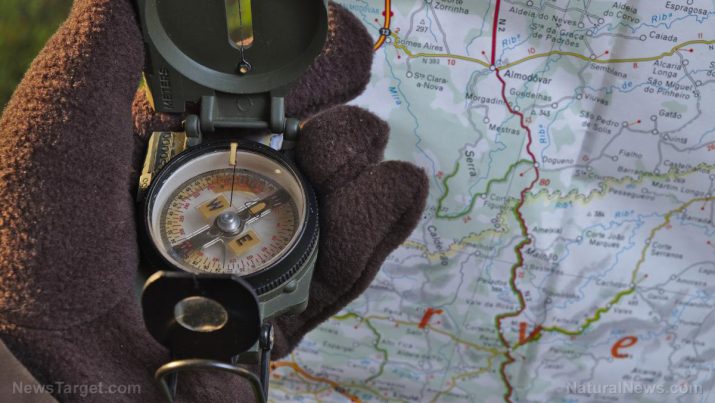A guide on compass navigation in a world without GPS
Tuesday, October 01, 2019 by Edsel Cook
http://www.bugout.news/2019-10-01-a-guide-on-compass-navigation-without-gps.html

Can you find your way through the wilderness with only a magnetic compass? Compass-only navigation is a vital skill that all preppers must learn.
Start by setting the magnetic declination of the compass. The declination value appears in the latest topographical maps released by the U.S. Geological Survey (USGS).
If you have a map and know your current location, you must get the bearing to your destination. To find this, pick one end of the straight-edge side of the compass that doesn’t have the Direction of Travel arrow. Set that end on the starting point on the map.
Next, move the other end of the straight-edge on the destination. Doing so aims the Direction of Travel arrow in the right direction.
The bezel of the compass features parallel lines on its surface. These are orienting lines. Turn the black ring of the bezel until the orienting lines run parallel with the north/south lines on the map.
The helpful maps feature straight north/south lines on their sides. They also have a direction arrow on them.
Rotate the bezel until the zero degree mark becomes aligned with the north side of the map. The point where the orienting arrow and the bezel meet is the index line – it should read the right bearing. (Related: Can your inbuilt “compass” respond to changes in Earth’s magnetic field?)
How to navigate with a compass
Once you get the bearing or the direction that you need to go, you may start navigating with your compass. Align the desired bearing with the index point of the Travel of Direction arrow.
Hold the aligned compass before you with the arrow aimed away from your body. Turn your body until the north end of the needle moves over the Orienting Arrow, the outline seen beneath the magnetic needle.
Sometimes, the Orienting Arrow has two sides. In that case, get the north end of the needle hovering over the red part of the arrow. Experienced compass navigators nicknamed this “putting Red in the Shed.”
At this point, you are facing the right direction. The next step is to look for the most distant yet still-visible landmark in that area.
Proceed to that position. Following a visible landmark makes navigation more accurate than relying entirely on the needle of the compass.
By using a landmark, you may get around obstacles more easily while remaining sure that you are going in the right direction. You must also maintain awareness of your surroundings.
Once you reach the landmark, check your orientation. Make sure the index point remains on the right number, “put Red in the Shed” again, and select a new landmark.
Helpful tips for using compasses to guide your way
When navigating via compass, you must keep certain things in mind to ensure you get accurate bearings.
During the orientation process, make sure the compass stays level. The magnetic needle needs to move freely.
Likewise, avoid any metal when orienting the magnetic needle. Magnetic compasses are vulnerable to even small bits of metal like a staple.
Some areas have large deposits of metal ores. The magnetic fields of these underground metals will draw compasses toward them.
Topographical maps of these areas feature adjusted declination values that compensate for the effects of these ore deposits. Otherwise, you must rely on the direction of the sun and other cues.
Electric currents generate magnetic fields that also affect compasses. Stay away from batteries, electronics, power lines, and phone lines while getting oriented. And remember that electromagnetic pulses (EMPs) also disrupt compasses.
Sources include:
BeansBulletsBandagesAndYou.com
Tagged Under: Tags: compass, compass bearing, compass reading, how-to, navigation, navigation skills, outdoor navigation, preparedness, prepping, survival, survival skills, wilderness navigation

